7 Best Grass Types for Illinois
BY LYDIAN PINE | JUNE 6TH, 2023 | ILLINOIS, LAWN CAREA lush lawn is a dream for any homeowner, and achieving this goal with your Illinois lawn is possible. It is much easier to grow a healthy lawn without an abundance of pesticides or fertilizers with the right grass variety. Discover the 7 best grass types for Illinois landscapes.
In this article, we will cover:
- Warm-Season vs. Cool-Season Grasses
- 7 Warm-Season and Cool-Season Grasses for Illinois
- FAQ About Illinois Grass Types
- Choosing Plant and Grass Varieties for Your Illinois Landscape
Warm-Season vs. Cool-Season Grasses
Warm-Season
Warm-season grasses perform best in the southern half of the U.S., entering active growth periods when temperatures range between 75 to 95 degrees Fahrenheit. Cultivars are typically drought-tolerant and require regular summer mowing sessions to keep blades short.
Illinois’ warm-season grasses green up in late spring or early summer and go dormant when temperatures turn cold in the fall through winter. For the best results, plant seeds in the summer or early fall.
Cool-Season
Cool-season grasses prefer northern climates and cold winters. These grasses remain green throughout most of the year and thrive in cooler temperatures between 55 to 75 degrees Fahrenheit. Cool-season grasses enter their green-up phases in fall and early spring and go dormant during the hot summer months.
Seed cool-season cultivars in the spring or fall. Unlike warm-season grasses, these specimens prefer taller mowing heights to keep blades healthy.
7 Warm-Season and Cool-Season Grasses for Illinois
The following warm and cool-season grass types adapt to the climatic and soil conditions of Illinois:
1. Centipedegrass
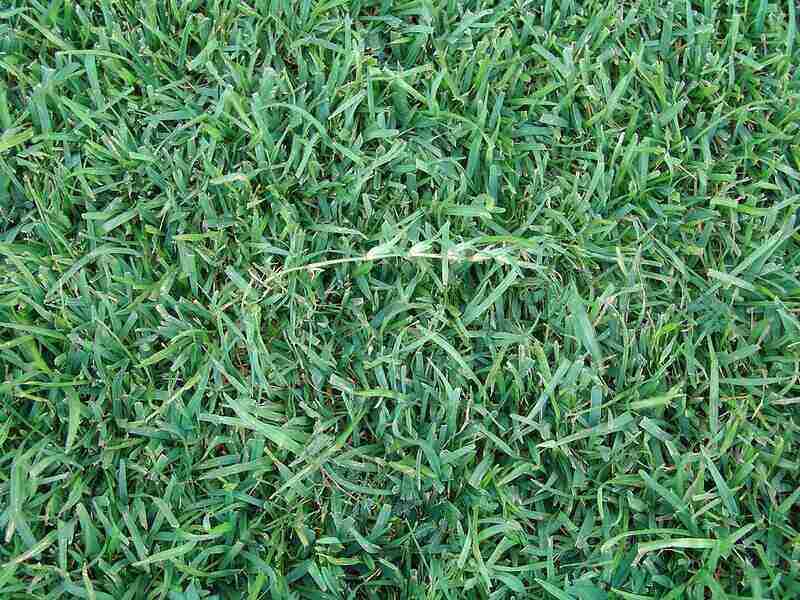
Photo Credit: James Becwar / Wikimedia Commons / CC0 1.0
Centipede grass is an excellent choice for Southern Illinois landscapes. It tolerates drought and requires little maintenance. Centipedegrass is a popular choice in coastal areas because it adapts to infertile, acidic soils, salt, and sand.
Many hybrid cultivars have increased cold tolerance. Centipedegrass requires adequate drainage and regular seeding until mature which typically takes two to three years. Specimens have coarse textures and light green colors. It has good shade and drought tolerance.
Classification: Warm-season grass
Spreads by: Stolons
Shade tolerance: Moderate — at least six hours of full sun per day
Drought resistance: Low to moderate
Foot traffic tolerance: Low
Maintenance needs: Low mowing frequency
Mowing height: 1.5-2 inches
Potential for disease: Moderate; prone to centipedegrass decline and iron chlorosis
Potential for pests: Moderate; prone to ground pearl insects, grubs, mole crickets, sod webworms, and lawn caterpillars
Soil pH: 5-6
Soil type: Acidic, infertile, at least moderately good drainage (very dense, clay soils produce poor results)
Other notes: Low maintenance once established; greenish-yellow color (like a green apple) during the growing season; low fertilizer and mowing requirements; not a salt-tolerant grass
2. Fine Fescue
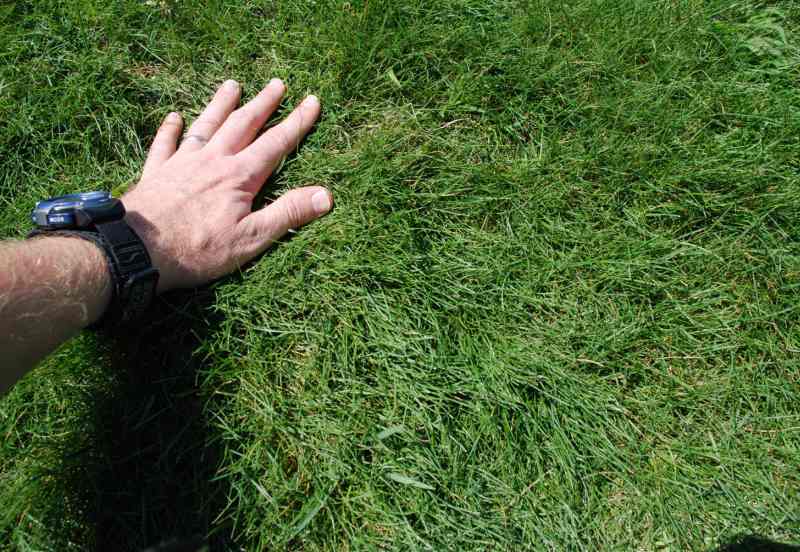
Photo Credit: Aaron Patton / Purdue’s Turfgrass Science Program
Fine fescue comes in many varieties, including creeping red fescue and hard fescue. It thrives throughout the Land of Lincoln and requires regular mowing. It is a clumping grass variety with a fine texture. Homeowners often mix fine fescue with other varieties like Kentucky bluegrass to create a resilient home lawn.
Fine fescue establishes quickly and has a deep green color. Cultivars are drought and cold-tolerant and grow well in poor soils. Fine fescue goes dormant during hot summers and prefers partially shaded areas. It is the most shade-tolerant of all the cool-season grass types.
Classification: Cool-season grass
Spreads by: Bunch-type grasses with one exception: creeping red fescues possess rhizomes
Shade tolerance: Moderate to high
Drought resistance: Moderate to high
Foot traffic tolerance: Low to moderate
Maintenance needs: Low
Mowing height: 1.5-3 inches
Potential for disease: Moderate; red thread, leaf spot, dollar spot, summer patch, powdery mildew, and downy mildew can occur
Potential for pests: Moderate; most common pests are chinch bugs, sod webworms, grubs, billbugs, winter mites, and crane flies
Soil pH: 5.5-6.5
Soil type: Well-drained soils; tolerates infertile and sandy soils
Other notes: Often used in a mix with other cool-season grasses, especially in sun/shade mixes
3. Kentucky Bluegrass
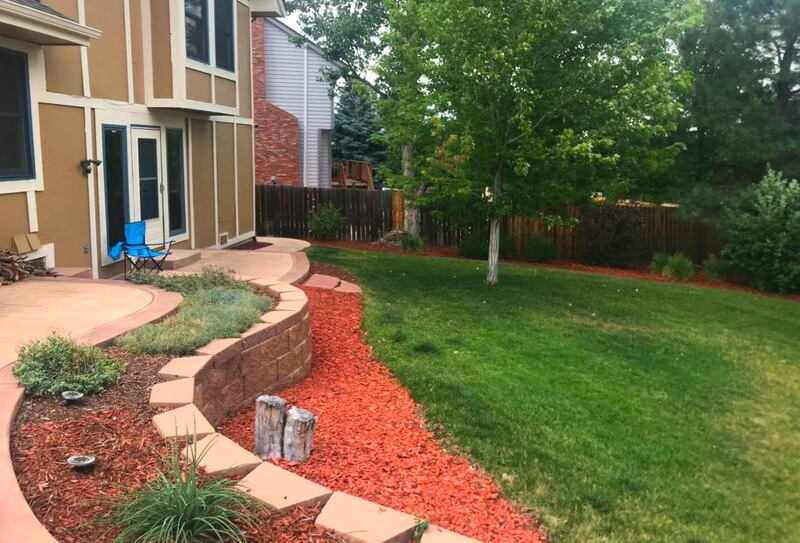
Photo Credit: Brenda Ryan / Wikilawn
Kentucky bluegrass is dark green with a dense, carpet-like texture that is the envy of the neighborhood. It grows well when seeded with other cultivars like tall or fine fescue and loves mild fall temperatures.
Kentucky bluegrass tolerates some shade but prefers full sun. It also does not require much water to grow well. However, it is susceptible to weeds, especially dandelions.
Classification: Cool-season grass
Spreads by: Rhizomes
Shade tolerance: Low to moderate; prefers full sun
Drought tolerance: Moderate
Foot traffic tolerance: Low to moderate; recuperates well
Maintenance needs: Moderate
Recommended mowing height: 2-3 inches; mow taller during summer
Potential for disease: Moderate to high; snow molds, summer patch, leaf spot, fairy rings, dollar spot, and necrotic ring spot can occur
Potential for pests: Moderate to high; most common pests are chinch bugs, bluegrass billbugs, grubs, and greenbugs
Soil pH: 6-7
Soil type: Well-drained, fertile soils
Other notes: It is most often mixed with other species. Regular watering is necessary because of its shallow roots. Poor soil conditions and lack of water can cause diseases, but newer cultivars are more hardy and resistant to disease.
4. Perennial Ryegrass
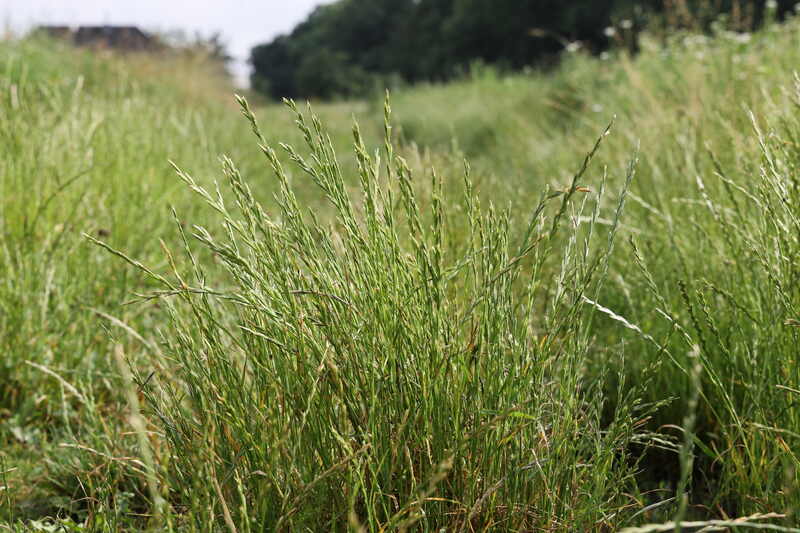
Photo Credit: T. Kebert / Wikimedia Commons / CC BY-SA 4.0
Perennial ryegrass grows best in the northern half of Illinois and does not grow well in high temperatures. It is a thick, dark green grass that stands up to heavy foot traffic and is pest-resistant. It establishes quickly and grows best in well-drained soils. Homeowners in the southern half of the state often use perennial ryegrass for winter overseeding to create a green lawn year-round.
Classification: Cool-season grass
Spreads by: Tillers (Bunch-type)
Shade tolerance: Low; requires four to five hours of sunlight
Drought tolerance: Low
Foot traffic tolerance: High; recuperates poorly
Maintenance needs: High; requires frequent watering, mowing, and fertilization
Recommended mowing height: 2-3 inches
Potential for disease: High; susceptible to flag rust, stem rust, leaf spot, downy mildew, brown patch, and red thread
Potential for pests: High; chinch bugs and greenbug aphids can occur
Soil pH: 6-7
Soil type: Adaptable; prefers well-drained, fertile soils
5. Rough Bluegrass
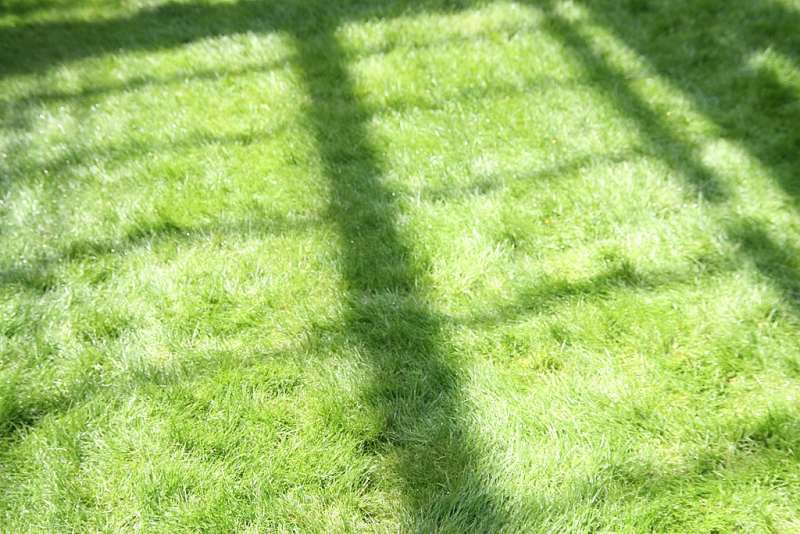
Photo Credit: David J. Stang / Wikimedia Commons / CC BY-SA 4.0
Rough bluegrass grows well in poorly draining, moist, shaded areas. It has soft, glossy blades that create an uneven appearance unless lying flat. Rough bluegrass is yellow-green and has low drought and disease tolerance. It does not stand up well to heavy foot traffic. However, cultivars tolerate occasional flooding.
Classification: Cool-season grass
Spreads by: Stolons
Shade tolerance: High
Drought resistance: Low
Foot traffic tolerance: Low
Maintenance needs: Moderate
Mowing height: 1 – 2 ½ inches
Potential for disease: High; susceptible to brown patch, fairy rings, gray snow mold, helminthosporium diseases, mushrooms, and puffballs
Potential for pests: High; ants, sod webworms, thrips, and white grubs can occur
Soil pH: 6 – 7
Soil type: Rich, moist soils
Other notes: Rough bluegrass is winter-hardy and great for colder months. However, it has a weedy appearance when blended with other grass types.
6. Tall Fescue
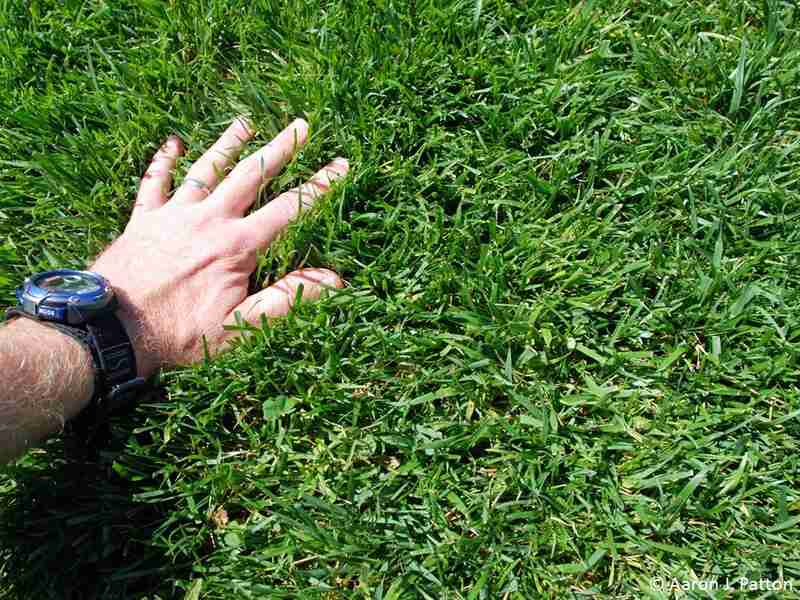
Photo Credit: Aaron Patton / Purdue’s Turfgrass Science Program
Tall fescue is a reliable, low-maintenance grass that is a great choice for northern Illinois. It tolerates both heat and cold. Tall fescue thrives in full sun and partial shade but needs to be irrigated to remain attractive during the summer.
Cultivars thrive in fertile, well-drained soil with a pH between 5.5 and 6.5 but adapt to other conditions. Tall fescue has a coarse texture, with a medium to dark green color and an extensive root system.
Classification: Cool-season grass
Spreads by: Tillers (Bunch-type)
Shade tolerance: Moderate to high
Drought tolerance: Moderate
Foot traffic tolerance: Moderate; recovers slowly
Maintenance needs: Moderate
Recommended mowing height: 2-4 inches (Check your cultivar and state recommendations. Many cultivars grow best when mowed on the tall side.)
Potential for disease: Low to moderate; can be prone to leaf spot, seedling disease, and brown patch
Potential for pests: Low to moderate; susceptible to armyworms, cutworms, sod webworms, and grubs
Soil pH: 5.5-6.5
Soil type: Adaptable; prefers clay soils
Other notes: Fertilize in September and November. Plant fresh grass seeds every couple of years to maintain a dense lawn and fill thinning spots.
7. Zoysiagrass
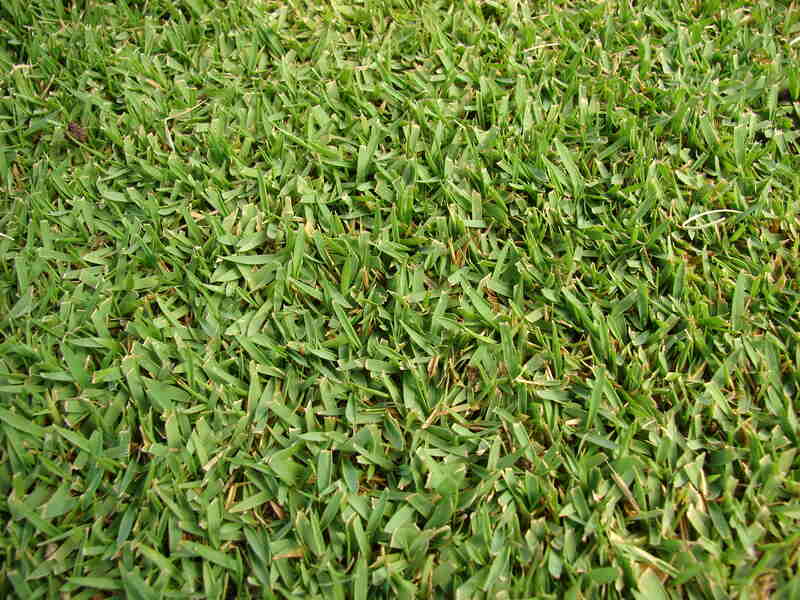
Photo Credit: Forest & Kim Starr / Wikimedia Commons / CC BY-SA 3.0
Zoysiagrass is a warm-season grass suited for southern Illinois. It grows well in warm temperatures and is drought-tolerant. Zoysiagrass is a dense grass that is light to medium green. It is weather-resistant and low-maintenance but establishes slowly.
Cultivars grow best in full sun, turning brown and entering dormancy in the fall. Zoysiagrass has low water needs and requires frequent mowing.
Classification: Warm-season grass
Spreads by: Stolons and rhizomes
Shade tolerance: Tolerates light to moderate shade
Drought resistance: High
Foot traffic tolerance: High
Maintenance needs: Low to moderate nitrogen requirement; moderate mowing frequency
Mowing height: 1-2.5 inches
Potential for disease: Low; large patch, root decline, spring dead spot, rust, curvularia, and leaf spot can occur
Potential for pests: Low; most common pests are mites, grubs, mole crickets, hunting billbugs, armyworms, chinch bugs, and sod webworms
Soil pH: 6-6.5
Soil type: Well-draining, some cultivars more tolerant of a wide range of soils than others
Other notes: Moderately salt tolerant; cut with sharp mower blade; mow taller if grass is in partial shade
FAQ About Illinois Grass Types
Grass stops growing in the fall when temperatures consistently remain between 40 to 50 degrees Fahrenheit.
For cool-season cultivars, fertilize your lawn in spring between February to May. Fertilize warm-season grasses from May to June.
The ideal time for seeding in Illinois is Mid-August to early September or in April. Avoid seeding in late spring or summer during dormancy.
Choosing Plant and Grass Varieties for Your Illinois Landscape
Are you looking for an extra set of hands to take care of your lawn? Picking out the right grass for your Illinois lawn is overwhelming. Let Wikilawn connect you with a local lawn care professional to take the hassle out of your yard work.
Photo Credit: Gary Todd / Flickr / Public Domain